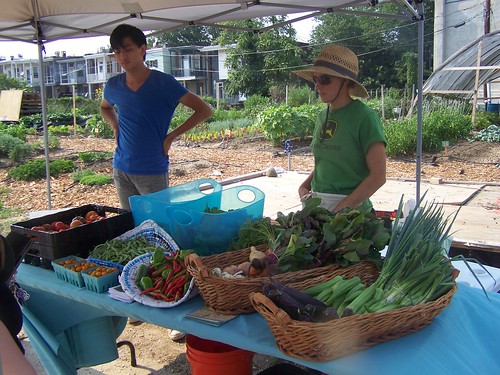(Urban) Food stuff
1. The Neighborhood Farm Initiative, a project of the America the Beautiful Fund, focuses on adult and teen gardening education, and will be hosting their third annual film fundraising event.
The event, held on August 11 at the Letelier Theater in the Georgetown neighborhood, will feature a screening of the documentary Truck Farm, live music, light local fare and wine, a conversation about urban agriculture, rooftop garden tours, and DC's very own truck farm. It will be a packed but fun evening - all following the theme of the movie and the Neighborhood Farm Initiative's mission: finding innovative ways to garden in urban areas. Tickets are $20, and all proceeds from the event will benefit the program.
-- NeighborhoodFarm@gmail.com
2. A study, but I would say the sample is too limited to generalize, in the Seattle area found that the cost of eating healthy is more expensive than people think. See the AP story "It Costs More To Eat Healthy Foods: University of Washington study finds widening gap between healthy and unhealthy foods."
I agree more with Parke Wilde, also quoted in the story:
Parke Wilde, associated professor at the Friedman School of Nutrition Science and Policy at Tufts University, said it's not expensive to get all the nutrients a body needs to meet the federal guidelines. What is expensive, in Wilde's opinion, are the choices Americans make while getting those nutrients. He said diets get more and more expensive depending on how many rules a person applies to himself, such as eating organic or seeking local sources for food or eating vegetables out of season.
E.g., if you only buy organically grown food at FreshFARM Markets, eating a healthier diet is definitely more expensive.
3. That being said, as a nation, we're getting fatter. See "America just keeps getting fatter: A comprehensive state-by-state report titled 'F as in Fat' shows that obesity rates continue to climb, along with diabetes and high blood pressure" from the Los Angeles Times.
-- F as in Fat: How Obesity Threatens America's Future 2011

4. California has an impressive new initiative that will implement a wide variety of strategies, tactics, and programs to improve access to healthier foods in communities that lack such access currently.
-- California FreshWorks Fund
From the "Introducing…The California FreshWorks Fund!" press release:
The fund will provide financing to grocery stores and other healthy food retailers and distributors who meet a subset of skillfully developed program guidelines designed to move healthy food retailing forward in an affordable and accessible way and prioritize healthy choices from top to bottom. CAFWF program guidelines are different from and go further than other previous efforts. For example: Projects will get priority points if they don't sell cigarettes, have higher proportion of healthy food retail, eliminate junk food aisles, etc.
Seed stage financing from The California Endowment included a $30 million mission-related investment on the debt side and a $3 million grant. In a matter of months the fund grew to $200 million committed from prominent investors like NCB, Kaiser Permanente, JP Morgan Chase, and others who felt strongly about the model and believed in its potential to transform underserved communities into communities of opportunity.
“It's ironic that some communities have an overwhelming need for access to healthy foods in a state that is one of the largest agricultural producers in the country", said Terry Simonette, President & CEO of NCB Capital Impact, the non-profit community development financial institution (CDFI) that serves as the program administrator of the California FreshWorks Fund. "The California FreshWorks Fund brings together an exceptional combination of private and non-profit partners to deliver a market-based solution to this problem in the absence of public subsidy,” Simonette added.
The priority scoring system for grants makes a lot of sense.

Kids from a downtown youth center leave Jamie Oliver's mobile teaching kitchen truck after taking part in a class. (Katie Falkenberg / For The Times)
5. I know I mentioned Jamie Oliver's healthy nutrition initiative's nutrition classroom truck outfit, the "Big Rig Teaching Kitchen," but it's still a cool idea. See "Jamie Oliver hits the road: The celebrity chef-activist's goal is to teach students healthy cooking in his kitchen-equipped big rig" from the Los Angeles Times.
6. But food prices are increasing. I had been reading about it but not experiencing it, but finally the places I go to get less expensive foods, such as bodegas, seem to have increased their prices quite a bit, although you can still get 6-7 limes for $1 in season.
7. All the more reason to have fruit and nut trees, fruit bushes, etc., as well as growing vegetables and herbs. See "Harnessing the abundance of urban orchards" from the Toronto Globe & Mail.
8. Like the programs discussed in the TGM article, Bread for the City in DC has a gleaning project focusing on fruit. If you want to volunteer, have a fruit tree they can pick, etc., contact gleaning@breadforthecity.org or use this online form.
They also have a rooftop garden which is quite cool.
9. The Whitelock Community Farm in the Reservoir Hill neighborhood in Baltimore sells vegetables from the farm on Friday evenings and Saturday mornings. They really know how to display their offerings. (And the beets were great.)
Labels: food-agriculture-markets, fruit and nut production, public health, urban agriculture, urban design/placemaking




0 Comments:
Post a Comment
<< Home